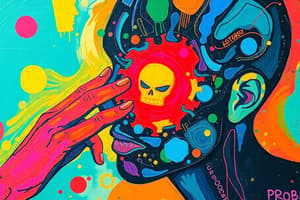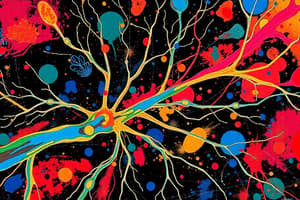Podcast
Questions and Answers
What system is responsible for identifying the presence, character, location, and intensity of pain?
What system is responsible for identifying the presence, character, location, and intensity of pain?
- Cognitive evaluative system
- Affective-motivational system
- Sensory-discriminative system (correct)
- None of the above
What is the role of the Affective-motivational system in pain perception?
What is the role of the Affective-motivational system in pain perception?
- It identifies the presence, character, location, and intensity of pain.
- It determines the individual's learned behavior concerning the experience of pain.
- It determines an individual's conditioned avoidance behaviors and emotional responses to pain. (correct)
- It determines the pain threshold for individuals.
Which of the following factors can decrease pain tolerance?
Which of the following factors can decrease pain tolerance?
- Increased sleep
- A calm environment
- A positive attitude
- Fatigue (correct)
What is pain threshold?
What is pain threshold?
Which brain structure is NOT directly involved in the affective-motivational system of pain perception?
Which brain structure is NOT directly involved in the affective-motivational system of pain perception?
What is the primary function of the cerebral peduncles in the midbrain?
What is the primary function of the cerebral peduncles in the midbrain?
Which structure within the midbrain is responsible for carrying cerebrospinal fluid (CSF) between the third and fourth ventricles?
Which structure within the midbrain is responsible for carrying cerebrospinal fluid (CSF) between the third and fourth ventricles?
Damage to which specific area of the midbrain can lead to akinetic mutism?
Damage to which specific area of the midbrain can lead to akinetic mutism?
Which of the following is NOT a characteristic of Parkinsonism?
Which of the following is NOT a characteristic of Parkinsonism?
What specific role does the CSF play in protecting the brain?
What specific role does the CSF play in protecting the brain?
What is the primary function of the arachnoid villi?
What is the primary function of the arachnoid villi?
Where is CSF primarily produced?
Where is CSF primarily produced?
What is the primary site of CSF absorption?
What is the primary site of CSF absorption?
Which of the following areas is NOT where enkephalins are concentrated?
Which of the following areas is NOT where enkephalins are concentrated?
What is the primary function of Endorphins?
What is the primary function of Endorphins?
Which of the following opioid receptor types is Dynorphin most strongly associated with?
Which of the following opioid receptor types is Dynorphin most strongly associated with?
In what circumstance can Dynorphins paradoxically contribute to pain sensation?
In what circumstance can Dynorphins paradoxically contribute to pain sensation?
What is a seizure defined as?
What is a seizure defined as?
Which of the following statements about Enkephalins is TRUE?
Which of the following statements about Enkephalins is TRUE?
Which of the following is NOT a symptom of a seizure?
Which of the following is NOT a symptom of a seizure?
What is the primary mechanism by which endogenous opioids, like Dynorphins, influence pain perception?
What is the primary mechanism by which endogenous opioids, like Dynorphins, influence pain perception?
Which of the following is NOT a factor that can DECREASE pain tolerance?
Which of the following is NOT a factor that can DECREASE pain tolerance?
Which of the following is considered a medical emergency?
Which of the following is considered a medical emergency?
Which of the following activities can potentially INCREASE pain tolerance?
Which of the following activities can potentially INCREASE pain tolerance?
Which of the following is NOT a potential long-term consequence of seizures?
Which of the following is NOT a potential long-term consequence of seizures?
What is a common cause of status epilepticus?
What is a common cause of status epilepticus?
What is the primary genetic risk factor associated with late-onset Alzheimer's disease?
What is the primary genetic risk factor associated with late-onset Alzheimer's disease?
Which of the following is NOT a clinical manifestation of Alzheimer's disease?
Which of the following is NOT a clinical manifestation of Alzheimer's disease?
Which of the following statements about early-onset familial Alzheimer's disease (FAD) is TRUE?
Which of the following statements about early-onset familial Alzheimer's disease (FAD) is TRUE?
Which of the following is a treatment for Alzheimer's disease aimed at maintaining cognitive function?
Which of the following is a treatment for Alzheimer's disease aimed at maintaining cognitive function?
Which of the following is a diagnostic tool used to assess the progression of Alzheimer's disease?
Which of the following is a diagnostic tool used to assess the progression of Alzheimer's disease?
Which of the following is used to screen for early-onset Alzheimer's disease?
Which of the following is used to screen for early-onset Alzheimer's disease?
What is the primary mechanism by which amyloid beta protein fragments contribute to Alzheimer's disease pathology?
What is the primary mechanism by which amyloid beta protein fragments contribute to Alzheimer's disease pathology?
Which of the following is NOT a clinical criterion for brain death?
Which of the following is NOT a clinical criterion for brain death?
Which of the following injuries can lead to vomiting due to direct involvement of the central neural mechanism?
Which of the following injuries can lead to vomiting due to direct involvement of the central neural mechanism?
What is the difference between brain death and cerebral brain death?
What is the difference between brain death and cerebral brain death?
Which of the following is a sign of a diminished level of consciousness (LOC)?
Which of the following is a sign of a diminished level of consciousness (LOC)?
Which of the following is a direct cause of vomiting in CNS disorders?
Which of the following is a direct cause of vomiting in CNS disorders?
Why is a rising PaCO2 above 60mmhg without breathing efforts considered a clinical criterion for brain death?
Why is a rising PaCO2 above 60mmhg without breathing efforts considered a clinical criterion for brain death?
What does the phrase "alert and oriented to self, others, place, and time" indicate?
What does the phrase "alert and oriented to self, others, place, and time" indicate?
Which of the following statements is TRUE about vomiting, yawning, and hiccups?
Which of the following statements is TRUE about vomiting, yawning, and hiccups?
Flashcards
Pain perception
Pain perception
The conscious awareness of pain generated by the brain's systems.
Sensory-discriminative system
Sensory-discriminative system
Identifies presence, character, location, and intensity of pain via the somatosensory cortex.
Affective-motivational system
Affective-motivational system
Determines emotional responses and avoidance behaviors related to pain.
Cognitive evaluative system
Cognitive evaluative system
Signup and view all the flashcards
Pain threshold
Pain threshold
Signup and view all the flashcards
Cerebral Peduncles
Cerebral Peduncles
Signup and view all the flashcards
Cerebral Aqueduct
Cerebral Aqueduct
Signup and view all the flashcards
Automatic Body Functions
Automatic Body Functions
Signup and view all the flashcards
Akinetic Mutism
Akinetic Mutism
Signup and view all the flashcards
CSF Functions
CSF Functions
Signup and view all the flashcards
Arachnoid Villi
Arachnoid Villi
Signup and view all the flashcards
Hydrocephalus
Hydrocephalus
Signup and view all the flashcards
Parkinsonism
Parkinsonism
Signup and view all the flashcards
Level of Consciousness (LOC)
Level of Consciousness (LOC)
Signup and view all the flashcards
Altered Consciousness
Altered Consciousness
Signup and view all the flashcards
Vomiting in CNS injuries
Vomiting in CNS injuries
Signup and view all the flashcards
Medulla Oblongata Functions
Medulla Oblongata Functions
Signup and view all the flashcards
Brain Death
Brain Death
Signup and view all the flashcards
Vegetative State
Vegetative State
Signup and view all the flashcards
Apnea in Brain Death
Apnea in Brain Death
Signup and view all the flashcards
Diplopia and Vomiting
Diplopia and Vomiting
Signup and view all the flashcards
Endogenous Opioids
Endogenous Opioids
Signup and view all the flashcards
Enkephalins
Enkephalins
Signup and view all the flashcards
Endorphins
Endorphins
Signup and view all the flashcards
Dynorphins
Dynorphins
Signup and view all the flashcards
Endomorphins
Endomorphins
Signup and view all the flashcards
Tolerance to Pain
Tolerance to Pain
Signup and view all the flashcards
Pain Management Techniques
Pain Management Techniques
Signup and view all the flashcards
Opioid Receptors
Opioid Receptors
Signup and view all the flashcards
Amyloid Beta Accumulation
Amyloid Beta Accumulation
Signup and view all the flashcards
Diffuse Neuritic Plaques
Diffuse Neuritic Plaques
Signup and view all the flashcards
Apolipoprotein E (ApoE4)
Apolipoprotein E (ApoE4)
Signup and view all the flashcards
Early-Onset Familial Alzheimer's Disease (FAD)
Early-Onset Familial Alzheimer's Disease (FAD)
Signup and view all the flashcards
Clinical Diagnosis of Alzheimer's
Clinical Diagnosis of Alzheimer's
Signup and view all the flashcards
Cholinesterase Inhibitors
Cholinesterase Inhibitors
Signup and view all the flashcards
NMDA Receptor Antagonist
NMDA Receptor Antagonist
Signup and view all the flashcards
Genetic Susceptibility Tests
Genetic Susceptibility Tests
Signup and view all the flashcards
Seizure
Seizure
Signup and view all the flashcards
Status Epilepticus
Status Epilepticus
Signup and view all the flashcards
Signs and Symptoms of Seizures
Signs and Symptoms of Seizures
Signup and view all the flashcards
Causes of Status Epilepticus
Causes of Status Epilepticus
Signup and view all the flashcards
Complications of Status Epilepticus
Complications of Status Epilepticus
Signup and view all the flashcards
Study Notes
Pathologic Alterations: Organs and Systems
- Afferent nerves transmit signals toward the spinal cord, while efferent nerves transmit signals away from the spinal cord.
- The cerebral cortex is the largest part of the brain, responsible for higher-level functions like reasoning and personality.
- The cerebellum is responsible for coordination and balance.
- Myelinated nerve fibers in the peripheral nervous system (PNS) are capable of regeneration.
Nerves Capable of Regenerating
- Local changes occur when an axon is cut, including retraction of the cut ends and phagocytosis of damaged tissue by macrophages and Schwann cells.
- The cell body undergoes chromotolysis, a phenomenon of swelling and loss of internal structures (nissl bodies).
- Antegrade (Wallerian) degeneration occurs in the distal axon, beginning within a few days.
- Retrograde changes occur at the proximal end of the injured axon, similar to antegrade changes.
- Regeneration occurs at a rate of approximately 1mm per day, limited to myelinated fibers in the peripheral nervous system.
- The closer to the cell body the injury is, the less likely the nerve cell will regenerate.
Brain Anatomy Review
- The forebrain, midbrain, and hindbrain are the three major divisions of the brain.
- The forebrain (prosencephalon) has two main divisions, telencephalon and diencephalon.
- The midbrain (mesencephalon) is responsible for connecting the hindbrain with the forebrain.
- The hindbrain (rhombencephalon) has two main divisions, metencephalon and myelencephalon.
- The reticular activating system is responsible for wakefulness and arousal.
- The brain weighs approximately 3 pounds.
Three Major Divisions of the Brain
- A detailed listing of each major aspect for the different parts of the brain.
Studying That Suits You
Use AI to generate personalized quizzes and flashcards to suit your learning preferences.




